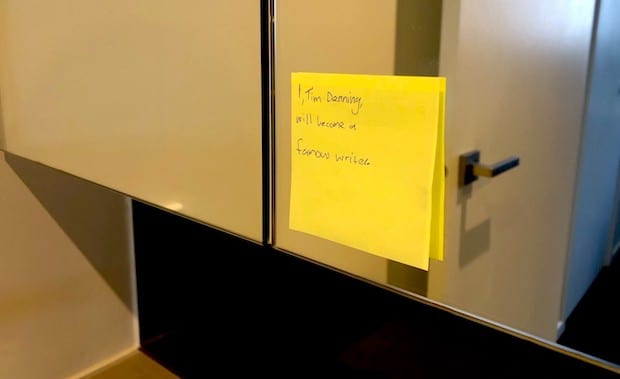Success Advice
What You Can Learn From “Neil Gaiman’s “Make Good Art” Speech

One of the best speeches that will teach you about life is Neil Gaiman’s “Make Good Art” Video on YouTube. I haven’t watched it for some time and was inspired to revisit it after watching a great piece of artistry online. The art that stood in front of my eyes was a group of glow in the dark drones that was combined with beautiful, female, western dancing.
It was truly magnificent, and it made me feel like I was in another world in a far away galaxy. For that moment, everything I was thinking about and all my troubles seemed to disappear – that’s what good art does.
Everything you do in life should be treated like art. Art is something that you respect and something you care about. Your life’s work should tick both of these box’s; otherwise, you will never be fulfilled. Lack of fulfillment is a steep descent into a dark hole of failure that you may never get out of.
So with that said, here is my twist on the 16 lessons you can learn from the “Make Good Art” speech by Neil Gaiman:
1. Make it up as you go along
We have become obsessed with planning our lives and wanting to know how everything is going to turn out. Sometimes, when something doesn’t turn out it can pave the way for another amazing event to happen in your life.
Forget about wanting to know the future, take a moment to think, and then start creating the next few years of your life. Create something that is your art.
2. List down what you want to do and then go do it
Rather than follow a plan, list down what you want to do in life and then just go and do everything on that list. It will take you on an adventure that you will never forget, and you’ll be living life on your terms.
The list you write down should include some activities that involve you making good art and unlocking your creative side.
3. Rules only tell you what is possible
The problem with living life to a set of rules is that rules only allow you to achieve what is currently possible. Success is about doing what is impossible or what seems like a wild dream that will never be achieved. The game of life get’s even harder when you try and follow someone else’s rules.
“When the rules you live by belong to someone else, the goal posts will continue to change, and your life will become a cat and mouse game with happiness.” – Tim Denning
When you forget about having rules you can achieve what seems impossible. That’s how the winners become so successful, and that’s why everyone recognises who they are. No one wants to give a standing ovation to someone who followed the rules.
Rules destroy creativity. Creativity breeds impossible adventures that take your life on a new path. Throw out the concept of rules, form some millionaire habits, and then go crush your goals to smithereens.
4. Ask questions – find out how the world works
Making your life into a masterpiece of art requires you to get some world-class strategies. The habit we all lack is to ask lots of questions. Don’t be afraid to sound dumb.
“Ask questions and learn from those who have achieved the different pieces of the jigsaw puzzle that make up your picture of success in your mind”
Questions require a creative mind to think about what’s missing and to track down the people that can answer those questions with a level of knowledge that is unmatched. Don’t settle for second best and use your hustle to ask good questions to those who have achieved their dreams.
5. Keep walking towards the mountain
Picture the mountain as the dream that your heart longs for. Whenever someone tries to take you on a route that bypasses the mountains trail by asking you to do something that is not you, say no. That mountain that you look at can only be climbed when you make good art to reach its peak.
It will take the creative part of your mind to find a way up the mountain, and it will use all of your physical capacity and emotion. There will be tough times as you try and climb the mountain but once you have reached its peak, the view of your dream from up top will make it all worth it.
Always keep the mountain in your sights by creating good art.
6. Only do things that feel like an adventure
Anything that feels like work will make you feel exhausted. Working hard at your passion doesn’t feel like work at all. Working on your passion feels like an adventure that you never want to stop being on. If you’re telling yourself each day that you have to go to work then you’re not creating art, you’re helping someone else make their art.
Your art is your own quest for adventure. Make that art the best damn way you know how and don’t ever give up!
7. Hundreds of bottles go out for every one bottle that comes back
Your life’s work involves creating lots of pieces of art that you send out into the world. These pieces of art are like putting messages in a bottle and placing them into the ocean in the hope that one bottle comes back.
When you are making art, occasionally one bottle will come back from time to time. Blogging is a great example of this. I write articles every day, and occasionally one hits the spot and gives me the energy I need to go to the next level.
As you become more successful, you then have the opposite problem; too many bottles will come back. At this point, you then need to become more focused on your art to narrow down the bottles that come back.
8. Don’t do it for the money
When you do anything in life only for money and then for some reason you don’t get paid, your mind can feel like you have nothing. If you make good art and do work you’re proud of then if you never get paid, at least you will have the art you created.
The lessons that will take you forward can only be learned from tasks that come from your art. Your art is your life’s journey and without it, you will be trapped in a maze of disappointment, resentment, and fear.
9. None of us know what we’re doing so enjoy the success
When you achieve success, your mind can tell you that you’re a fraud, and eventually the world will work out that you have no idea what you’re doing – none of us do. Don’t let your mind keep lying to you. Your success is a direct result of the art you make. There are no rules on how to achieve beautiful art that the world loves. So, make good art and enjoy any success you get.
10. Making mistakes means you are doing something
If you’re not making mistakes with your art, then you are probably doing nothing and not even trying to climb your mountain. There are so many couch commentators who can tell you everything about how your art should be created – none of them have ever created this so-called artwork themselves, though.
Increase your rate of failure and watch how beautiful your art becomes. Watch people admire you and be inspired by your influence. The art of “doing” is what will make you successful not the art of thinking about what you need to do.
11. When you feel naked, you’re starting to get it right
We all wear a mask, afraid of what others will think of us. The moment you take that mask off and reveal yourself to the world is the moment your art will become phenomenal. The more personal your story gets, the more people will love your art.
The art that doesn’t work out teaches you just as much as the art that causes people’s mouths to drop when they see it. Don’t be afraid to fail. Fail fast and move on.
12. When things get tough make good art
There are so many things that can go wrong in our life. We can lose a family member, have our heart broken by that special someone, or be turned down for the very art we love so much.
No matter what, make good art. Your art is what get’s you through the tough times and it’s what make’s the good times feel so amazing. Without your art, there are no good times. All there is without your art is empty space; empty time.
13. Time takes the sting away
Even if everything goes horribly wrong, you always have your art as long as your mind never forgets this one universal truth. The toughest of times can all be healed through the passing of time. Eventually, your heart will reform, and you will be back to your unstoppable self again.
Nothing lasts forever except true art. Your art, your passion, what you give to the world, and your love for other people are all you’ve got. They are the secret ingredients to the dream that makes up your mountain.
14. Start out by copying and then find your own voice
At first, you will probably start out by copying someone else’s art. That’s okay. The best example I have seen of this is Tony Robbins. Many of you probably don’t know that Tony started out by teaching the works of Napoleon Hill. A lot of Tony’s early work is based on the book “The Law Of Success.”
Through the years, Tony has transformed Napoleons work and made his own unique art. This would never have happened unless he started out by teaching Napoleons artwork first. It’s not about creating art that is different; it’s about creating art that is uniquely you. What do you have to show the world?
15. The Internet only makes your art better
The Internet, software, and data is changing the game. This is perfect for making art because it means no one knows what the future will be like, so you can focus on your art, and create the future yourself. When you realise that change only makes your art better, you will embrace it. You will develop that mental clarity that makes the clouds around your mountain disappear.
16. Pretend you can do it
What stops us from making good art is that we don’t believe we can. If you learn to start making your art and pretend you’re good at it, then one day you will be.
Look at me I’m no blogger. I just pretend I am and pretend my advice is good even if it’s not. In the end, if I believe I can be a blogger then I can be. All it takes is practice and time to be good at your art.
What does making good art mean to you? Let me know on my website timdenning.net or my Facebook.
Life
10 Research-Backed Steps to Create Real Change This New Year
This New Year could finally be the one where you break old patterns and create real, lasting change.

Every New Year, we make plans and set goals, but often repeat old patterns. (more…)
Change Your Mindset
The Silent Skill That Makes People Respect You Instantly
What truly earns respect and why most people go about it the wrong way

Everybody craves respect but not everyone earns it. Some people believe that a title, years of experience, or a position of authority automatically entitles them to respect. (more…)
Entrepreneurs
The Essential Skills Every Entrepreneur Needs In 2026
Success in the digital age isn’t about luck. It’s about mastering the skills that separate dreamers from doers.

When I was 22 years old, I started my first side hustle as a ghostwriter. (more…)
Did You Know
The Success Patterns You Inherited (And Didn’t Notice)
Your family history may hold the key to why you think, act, and feel the way you do today.

Who are you? Your experiences and your family’s narratives and legacies contribute to your identity. Your ancestry contains individual traits and forces that have been inherited over the years. It also carries the fights and victories of your forebears and older family members. (more…)
-

 Personal Development4 weeks ago
Personal Development4 weeks agoThis Silent Habit Might Be Sabotaging Your Career
-

 Business4 weeks ago
Business4 weeks agoWhy Your E-Commerce Fulfilment Is Probably Broken (And How to Fix It)
-

 Shift Your Mindset3 weeks ago
Shift Your Mindset3 weeks ago11 E’s That Define Every Great Leader And Why Most People Miss Them
-

 Did You Know3 weeks ago
Did You Know3 weeks agoThe Success Patterns You Inherited (And Didn’t Notice)
-

 Business3 weeks ago
Business3 weeks agoThe Hidden Money Pit in Your Operations (and How to Use It)
-

 Entrepreneurs2 weeks ago
Entrepreneurs2 weeks agoThe Essential Skills Every Entrepreneur Needs In 2026
-

 Change Your Mindset2 weeks ago
Change Your Mindset2 weeks agoHow to Turn Your Mind Into Your Greatest Asset (Instead of Your Enemy)
-

 Change Your Mindset1 week ago
Change Your Mindset1 week agoThe Silent Skill That Makes People Respect You Instantly





















6 Comments